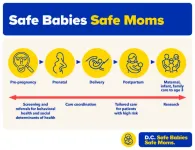(Press-News.org) The Tomosynthesis Mammographic Imaging Screening Trial (TMIST) has reached its enrollment goal of 108,508 women, as announced today by the ECOG-ACRIN Cancer Research Group (ECOG-ACRIN). The study, funded by the National Cancer Institute (NCI), one of the National Institutes of Health, will now proceed with the completion of regularly scheduled mammograms and follow-up on all participants through 2027. Key in this follow-up is the collection of biospecimens and data that will help researchers learn how to personalize breast cancer screening for women.
Participants in TMIST were randomly assigned to receive either 2-D (standard) or 3-D mammograms[AV1] . TMIST is the first randomized controlled trial aimed at identifying women for whom digital breast tomosynthesis (DBT or 3-D mammography) may be more effective than two-dimensional (2-D) digital mammography in reducing the risk of advanced breast cancer. The 3-D mammography technique takes multiple images of the breast from different angles to create a three-dimensional image.
Despite being in use for the last decade, there has not been clinical evidence that 3-D outperforms traditional 2-D mammograms in detecting aggressive breast cancers. Both methods involve compression of the breast along with radiation exposure. The ability of these different technologies to detect advanced cancers is being compared; while 3-D mammography has been seen to find more cancer, it is unknown if these additional cancers found are ones that are advanced and more likely to cause death. Primary TMIST results may be published as early as 2028.
"Strong recruitment rapidly increased enrollment despite a worldwide pandemic that has kept breast cancer screening rates below pre-COVID-19 levels,” said TMIST Study Chair Etta D. Pisano, MD, FACR. “We are proud of these recruitment efforts and diverse study population, which includes participants in the United States, Argentina, Canada, and other countries. “We are excited to continue gathering and analyzing images, biospecimens, and data as we power toward the publication of TMIST results.”
TMIST is also creating significant future opportunities by developing the world's largest curated dataset of breast cancer screening images, clinical data, and biospecimens. This comprehensive dataset will be available to researchers, enabling them to discover new screening strategies and tools. These advancements may help physicians to provide personalized recommendations for each woman, taking into account her risk factors, individual circumstances, and genetics.
"The primary TMIST study question is whether tomosynthesis or 3-D mammography is more sensitive for those breast cancers that are more likely to lead to a woman's death from breast cancer," said Dr. Pisano. "Although prior studies suggest that tomosynthesis screening finds more cancers than 2-D, we do not know if it leads to more lives saved. Does it lead to a reduction in aggressive cancers because they are found earlier, such as triple-negative breast cancer, for example? If TMIST finds a reduction in aggressive cancers, it would suggest tomosynthesis is saving more lives than the older technology."
TMIST data will also assist doctors in improving the process of identifying women at high risk for developing cancer, as well as in optimizing the use of both mammographic technologies in the future.
A major strength of the TMIST cohort is its diversity and representation of women from around the globe. Worldwide, 48% of TMIST participants are Hispanic or Latino. To support the recruitment of diverse populations, promotion and education resources were published in multiple languages, which facilitated the involvement of hospitals, cancer centers, and clinics (sites) that serve diverse communities. Furthermore, ECOG-ACRIN collaborated with the American College of Radiology® (ACR®) to enhance recruitment efforts. As a result, TMIST has become one of the most racially diverse populations of any NCI trial.
In the United States, fewer than half of all accredited mammography scanners are 3-D units, and 10% of imaging facilities in the US do not have any 3-D scanners. Many of these facilities are in medically under-served geographic areas. Further, a study published in the Journal of the American College of Radiology (JACR®) showed that Black women are far less likely to be screened with 3-D than white or Asian women.
“We are encouraged by the diversity of patients in TMIST. Considering the high breast cancer mortality rates among individuals in under-served populations, TMIST’s diverse patient group carries the potential to help us better understand the disease’s predictive factors, improve early detection for as many women as possible, and lead to better, more individualized screening strategies,” said ECOG-ACRIN Health Equity Committee Chair Melissa A. Simon, MD, MPH.
ECOG-ACRIN leads TMIST (NCT03233191), with support from the National Cancer Institute. TMIST is being conducted at 133 study sites worldwide. Countries include Argentina, Canada, Chile, Peru, Italy, South Korea, Spain, Taiwan, Thailand, and the United States. Many TMIST sites in the US are outside of major cities through the NCI Community Oncology Research Program (NCORP). The ACR Center for Research and Innovation™ manages trial implementation at TMIST sites.
“Finding and enrolling a large enough sample size within a reasonable time can be difficult in randomized clinical trials, especially when targeting a specific population. By setting records for the diversity and scope of TMIST, the cancer cooperative groups have proven we are the ideal setting for large-scale screening and prevention trials,” said ECOG-ACRIN Group Co-Chair Mitchell D. Schnall, MD, PhD.
The collaborating cooperative groups consist of the Alliance for Clinical Trials in Oncology, the Canadian Cancer Trials Group, the ECOG-ACRIN Cancer Research Group, NRG Oncology, and the SWOG Cancer Research Network. These groups design and conduct clinical trials through the NCI National Clinical Trials Network (NCTN).
END
Large-scale TMIST breast cancer screening trial achieves enrollment goal, paving the way for data that provides a precision approach to screeninge
More than 108,000 women across the world joined the study of 2-D versus 3-D mammography
2025-01-15
ELSE PRESS RELEASES FROM THIS DATE:
Study published in NEJM Catalyst finds patients cared for by MedStar Health’s Safe Babies Safe Moms program have better outcomes in pregnancy, delivery, and postpartum
2025-01-15
WASHINGTON - Women who were cared for by the MedStar Health D.C. Safe Babies Safe Moms program (SBSM) have better outcomes in pregnancy, delivery, and postpartum, according to a study published today in NEJM Catalyst Innovations in Care Delivery. Additionally, the study showed that Black patients cared for by SBSM were also less likely to have low or very low birthweight babies or preterm birth than Black or White patients who received prenatal care elsewhere.
Compared to patients who received prenatal care elsewhere, patients cared for under Safe ...
Octopus arms have segmented nervous systems to power extraordinary movements
2025-01-15
Octopus arms move with incredible dexterity, bending, twisting, and curling with nearly infinite degrees of freedom. New research from the University of Chicago revealed that the nervous system circuitry that controls arm movement in octopuses is segmented, giving these extraordinary creatures precise control across all eight arms and hundreds of suckers to explore their environment, grasp objects, and capture prey.
“If you're going to have a nervous system that's controlling such dynamic movement, that's a good way to set it up,” said Clifton Ragsdale, PhD, Professor of Neurobiology at UChicago and senior author ...
Protein shapes can help untangle life’s ancient history
2025-01-15
The three-dimensional shape of a protein can be used to resolve deep, ancient evolutionary relationships in the tree of life, according to a study in Nature Communications.
It is the first time researchers use data from protein shapes and combine it with data from genomic sequences to improve the reliability of evolutionary trees, a critical resource used by the scientific community for understanding the history of life, monitor the spread of pathogens or create new treatments for disease.
Crucially, the approach works even with the ...
Memory systems in the brain drive food cravings that could influence body weight
2025-01-15
PHILADELPHIA, PA (January 15, 2025) - Can memory influence what and how much we eat? A groundbreaking Monell Chemical Senses Center study, which links food memory to overeating, answered that question with a resounding “Yes.” Led by Monell Associate Member Guillaume de Lartigue, PhD, the research team identified, for the first time, the brain’s food-specific memory system and its direct role in overeating and diet-induced obesity.
Published in Nature Metabolism, they describe a specific population of neurons in the mouse brain that encode memories for sugar and fat, profoundly impacting food intake and body ...
Indigenous students face cumbersome barriers to attaining post-secondary education
2025-01-15
Indigenous students identified inadequate funding as a major barrier to completing post-secondary education according to a new study published in AlterNative: An International Journal of Indigenous Peoples.
The study surveyed Indigenous university students at Algoma University. The students, who identified as either First Nations or Métis, reported that they required multiple sources of funding, including government student loans and personal savings, to afford their post-secondary education. About two-thirds (69%) of students received funding for their education from First Nations sources, including funding from federal programs for Indigenous students.
“This ...
Not all Hot Jupiters orbit solo
2025-01-15
Hot Jupiters are giant planets initially known to orbit alone close to their star. During their migration towards their star, these planets were thought to accrete or eject any other planets present. However, this paradigm has been overturned by recent observations, and the final blow could come from a new study led by the University of Geneva (UNIGE). A team including the National Centre of Competence in Research (NCCR) PlanetS, the Universities of Bern (UNIBE) and Zurich (UZH) and several foreign universities has just announced the existence of a planetary system, WASP-132, ...
Study shows connection between childhood maltreatment and disease in later life
2025-01-15
University of Birmingham venture Dexter has demonstrated the power of its Dexter software platform in a study showing that people whose childhoods featured abuse, neglect or domestic abuse carry a significantly increased risk of developing rheumatoid arthritis or psoriasis in later life.
The starting point for the recently published study was a database of over 16 million Electronic Health Records, from which the Dexter software defined a cohort, one arm that was exposed to childhood maltreatment, and one arm that was not.
The software then checked the records over a 26-year period ...
Discovery of two planets sheds new light on the formation of planetary systems
2025-01-15
The discovery of two new planets beyond our solar system by a team of astronomers from The University of Warwick and the University of Geneva (UNIGE), is challenging scientific understanding of how planetary systems form.
The existence of these two exoplanets - an inner super-Earth and an outer icy giant planet - within the WASP-132 system is overturning accepted paradigms of how ‘hot Jupiter’ planetary systems form and evolve.
Hot Jupiters are planets with masses similar to those of Jupiter, but which orbit closer to their star than Mercury orbits the Sun. There is not enough gas and dust for these giant planets to form ...
New West Health-Gallup survey finds incoming Trump administration faces high public skepticism over plans to lower healthcare costs
2025-01-15
WASHINGTON, D.C. — Weddnesday, Jan. 15, 2025 — Nearly half of Americans (46%) think the country is headed in the wrong direction when it comes to the incoming president’s policies to lower healthcare costs, while 31% say it’s on the right track, according to the latest West Health-Gallup survey released today.
When viewed through a political lens, only Republicans are more positive than negative about the future of healthcare costs under the Trump administration; nearly three-quarters (73%) think the incoming administration’s healthcare policies are headed in the right direction. In contrast, 24% of independents and 3% of Democrats say the same. Democrats ...
Reading signs: New method improves AI translation of sign language
2025-01-15
Sign languages have been developed by nations around the world to fit the local communication style, and each language consists of thousands of signs. This has made sign languages difficult to learn and understand. Using artificial intelligence to automatically translate the signs into words, known as word-level sign language recognition, has now gained a boost in accuracy through the work of an Osaka Metropolitan University-led research group.
Previous research methods have been focused on capturing information about the signer’s ...
LAST 30 PRESS RELEASES:
Deep neural networks enable accurate pricing of American options under stochastic volatility
Collective risk resonance in Chinese stock sectors uncovered through higher-order network analysis
Does CPU impact systemic risk contributions of Chinese sectors? Evidence from mixed frequency methods with asymmetric tail long memory
General intelligence framework to predict virus adaptation based on a genome language model
Antibiotic resistance is ancient, ecological, and deeply connected to human activity, new review shows
Vapes, pouches, heated tobacco, shisha, cigarettes: nicotine in all forms is toxic to the heart and blood vessels
From powder to planet: University of Modena engineers forge a low-carbon future for advanced metal manufacturing
Super strain-resistant superconductors
Pre-school health programme does not improve children’s diet or physical activity, prompting call for policy changes, study finds
Autumn clock change linked to reduction in certain health conditions
AI images of doctors can exaggerate and reinforce existing stereotypes
Where medicine meets melody – how lullabies help babies and parents in intensive care
We may never be able to tell if AI becomes conscious, argues philosopher
AI video translation shows promise but humans still hold the edge
Deep ocean earthquakes drive Southern Ocean’s massive phytoplankton blooms, study finds
Without campus leftovers to pick through, the beaks of this bird changed shape during the pandemic
High-dose antibiotic does not reduce mortality in tuberculous meningitis
How many insects fly in the sky above the USA?
Could cheese protect your brain health?
Who faces more difficulty recovering from stroke?
Colliding galaxies create the brightest, fastest growing black holes at their center
New BrainHealth research reveals tradeoffs on sleep with cannabis use for chronic pain
Aging-US now on ResearchGate, enhancing visibility for authors and readers
'Molecular glue' stabilizes protein that inhibits development of non-small cell lung cancer
Mount Sinai Health System is recognized in 2025 Chime Digital Health Most Wired survey
From prey to predator: How carnivores spread beneficial fungi
Menopause symptoms may be frequent and have negative effects, according to female endurance athletes
US Congressmembers’ responses on X to mass shooting events differ along party lines
KAIST-UEL team develops “origami” airless wheel to explore lunar caves
Individual genetic differences render some therapies ineffective
[Press-News.org] Large-scale TMIST breast cancer screening trial achieves enrollment goal, paving the way for data that provides a precision approach to screeningeMore than 108,000 women across the world joined the study of 2-D versus 3-D mammography






